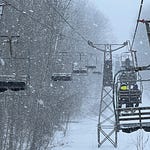The Storm Skiing Podcast is sponsored by Mountain Gazette - Listen to the podcast for discount codes on subscriptions and merch.
Who
John Emery, CEO of Alpine-X
Recorded on
August 2, 2021

Why I interviewed him
It’s such an odd conceit, isn’t it? Skiing indoors. Like surfing or mountain climbing or hunting or riding a bike, skiing belongs, in our collective imaginations, to the wide world and all its temperaments. But, as with climbing gyms or stationary bikes, technology has found a way to compartmentalize our outside pursuits, to give us a version of wild nature that’s completely walled off from it. As far as technology goes, it’s not exactly the Millennium Falcon: a big freezer on a hill covered with snow. In fact, the rest of the industrialized world has had indoor skiing for decades. Why not the U.S.? It has the population, the open land, the cultural default to canned experiences, and the wealth both to build these things and to visit them. Sure, there are plenty of ski resorts here, but they are concentrated in a few places. Thirteen states – including Florida and Texas, where a combined 50 million people live – don’t have a single ski area. And while these states have plenty of skiers of the annual-trip-to-Keystone variety, how many more would they have if anyone who wanted to try skiing could drive 20 minutes and do so? And how many of those, delirious from the rush down the decline, would then start to eye the distant snowy mountains and say, “let’s do this?”
So why, so far, has no one done it? Gone big on an experiment in U.S. indoor skiing? After Big Snow finally hummed to life nearly two years ago, Snow Operating discussed expansion south, possibly in Miami, but Covid muted such talks. When Alpine-X materialized out of ether this past January, they made their ambitions clear: to plant 20 indoor ski resorts – resorts, not areas – across the continental United States. It’s a bold and ambitious plan, and I wanted to know more.
What we talked about
How a string of corporate jobs outside of skiing readied Emery for a job running an indoor-ski startup; when your target demographic is “everyone”; the underappreciated and quirky world of Mid-Atlantic skiing; Covid upends the world in ways large and small; the global indoor-skiing landscape; how Ski Dubai changed the international conversation around domed skiing; the Great Wolf Lodge of skiing; tamping down the intimidation and embarrassment factors of learning to ski; avoiding the fate of the infamous Tokyo snowdome, which cost hundreds of millions to build and even more to tear down less than a decade later; the importance of an interesting ski experience; making skiing affordable; the necessity of terrain parks; why indoor skiing has yet to take off in the U.S. three decades after the technology debuted; Alpine-X’s potential U.S. footprint; what a good Alpine-X market looks like; imagine making after-work turns in Dallas or Miami; a skier-generation factory; why the first Alpine-X facility will be in Fairfax, Virginia; an option to get around Washington, D.C.’s impossible traffic problems; why it takes so long to built big things; the art of building atop a disused landfill; the difference between building on an existing hill versus building a steel ramp for skiing; the potential to build on natural hills; stats on the yet-to-be-built Fairfax hill; use of indoor skiing as a training facility; what kind of lifts we could see in the dome; a potential expansion timeline; how to avoid making the McDonald’s of indoor skiing; would an indoor ski dome work in a major outdoor ski market like Salt Lake City?; making indoor skiing beautiful; is there room for a second snowdome in the New York City metro area?; Alpine-X as a warm-weather feeder to outdoor ski resorts around the country; could indoor skiing draw 10 million skier visits per year?

Why I thought that now was a good time for this interview
Skiing, like all things outdoors, is having a moment. Covid did a lot of damage, but it also crushed a lot of bad habits and inspired a lot of good ones. Suddenly, the antiseptic indoors around which the core of American life revolves was the most dangerous place you could be. What else is there? In the winter? Well, skiing. As anyone who’s long made a habit of the sport knows, hordes flooded toward it this year as though it were a thing newly invented. Some will drift away, but many won’t. And as liftlines moderate with stuffed-full chairs this coming winter, that will probably be mostly a good thing.
What this past winter suggested was that if people are presented with an option to ski, they will try it. That’s what’s so compelling here. Southern U.S. cities are stuffed with people and money. Give them the option to ski, and they will. It’s a bit of the opposite of the Covid effect – the pandemic narrowed choices and forced would-be hibernators outdoors; indoor domes will expand options by taking skiing inside. Nonetheless, the outcome will be similar: more skiers.
We are at the very beginning of indoor skiing in the United States. These domes could very well become, within a decade or two, the primary pipelines feeding the nation’s sprawling resort network. They could also fail spectacularly. Either way, I wanted to tell this story from the beginning, when optimism and possibility were at their apex.

Questions I wish I’d asked
These facilities are expensive: Emery estimates the Fairfax facility will run $200 million. Alpine-X wants to build 20 of them. That’s $4 billion. I would have liked to talk a bit more about how the company planned to raise that kind of capital and how long it would take to pay off in a best- and worst-case scenario. That enormous upfront cost is, I’m assuming, why indoor skiing has yet to take root in the United States, and it would be interesting to hear how Emery solved that problem (though one would assume he plans to follow the same basic model he did to launch the now-established Great Wolf Lodge chain of similarly ambitious facilities).
Additional reading/videos
Ski’s overview of Alpine-X
A list of indoor ski areas around the world
My Storm Skiing Podcast interview with Big Snow VP of Marketing & Sales Hugh Reynolds (recorded in March 2020, just before the Covid shutdown)
Apparently there’s an outdoor snow-tubing operation in Florida already. Who knew?











